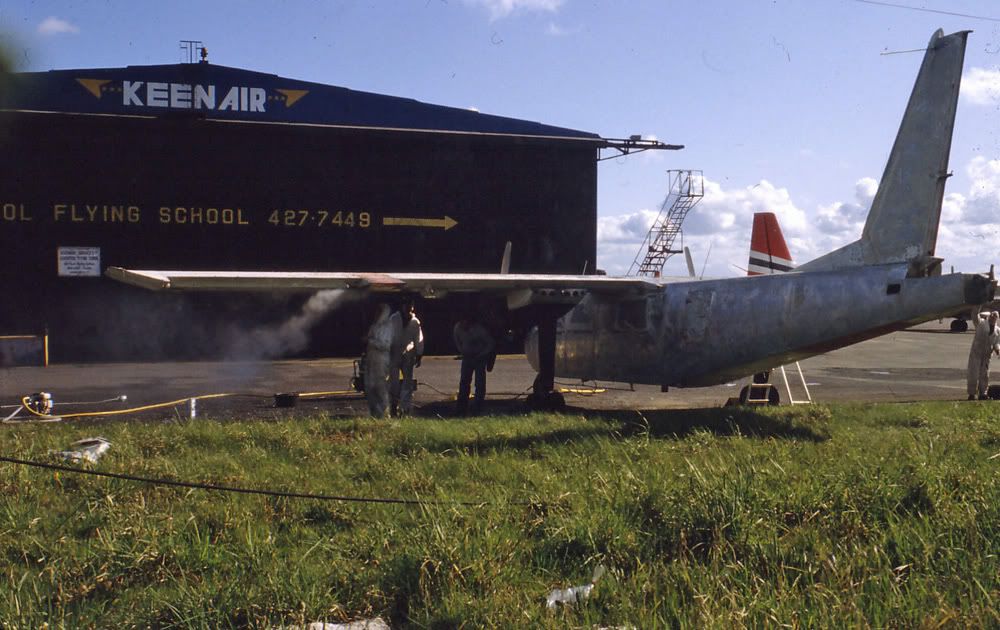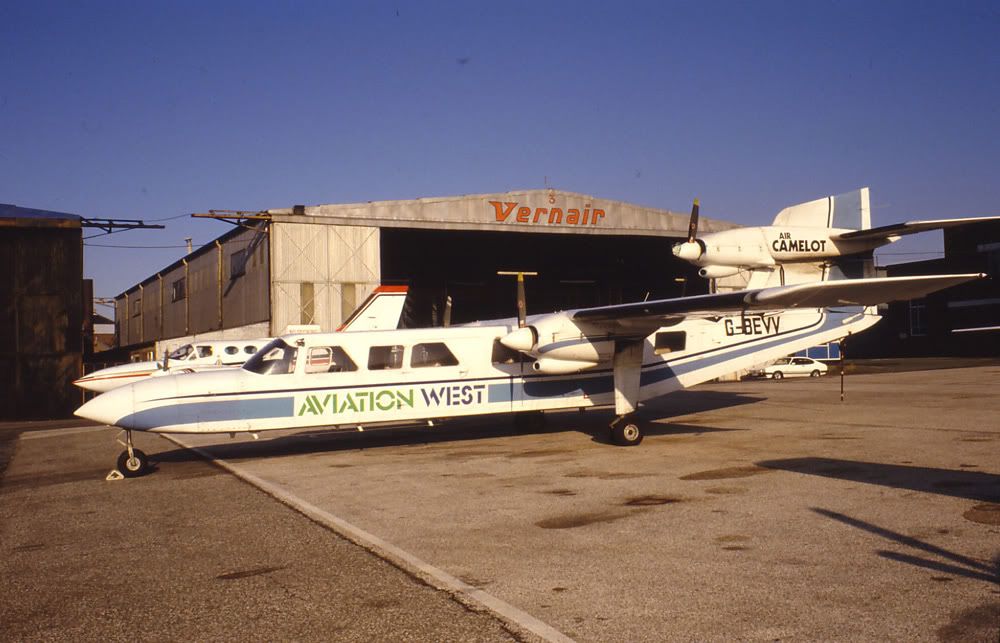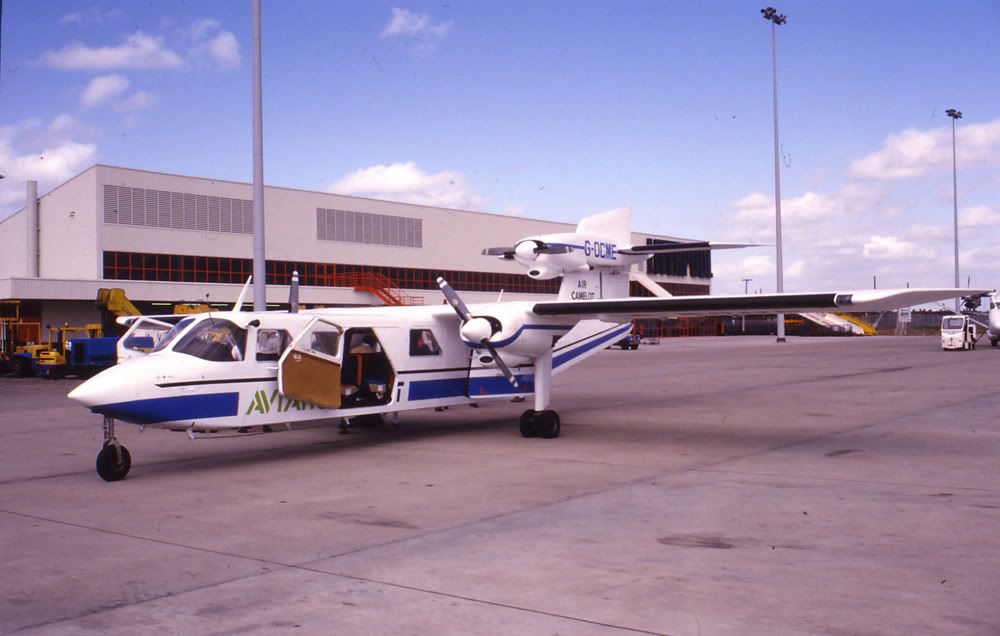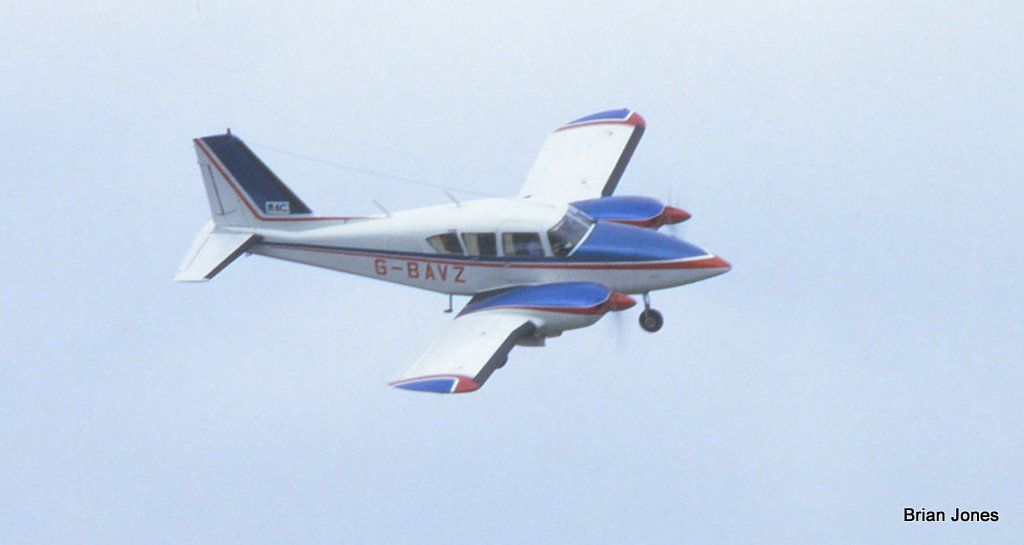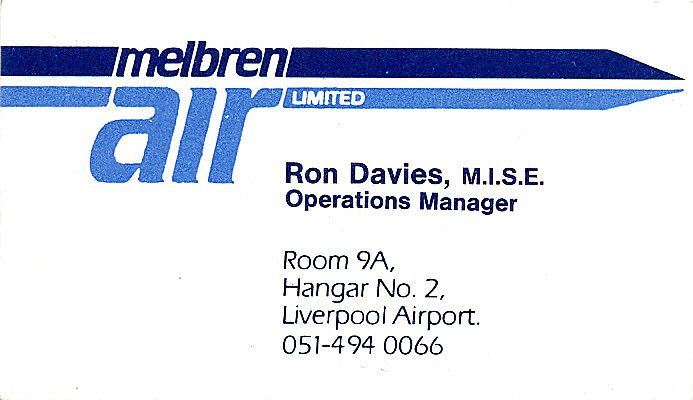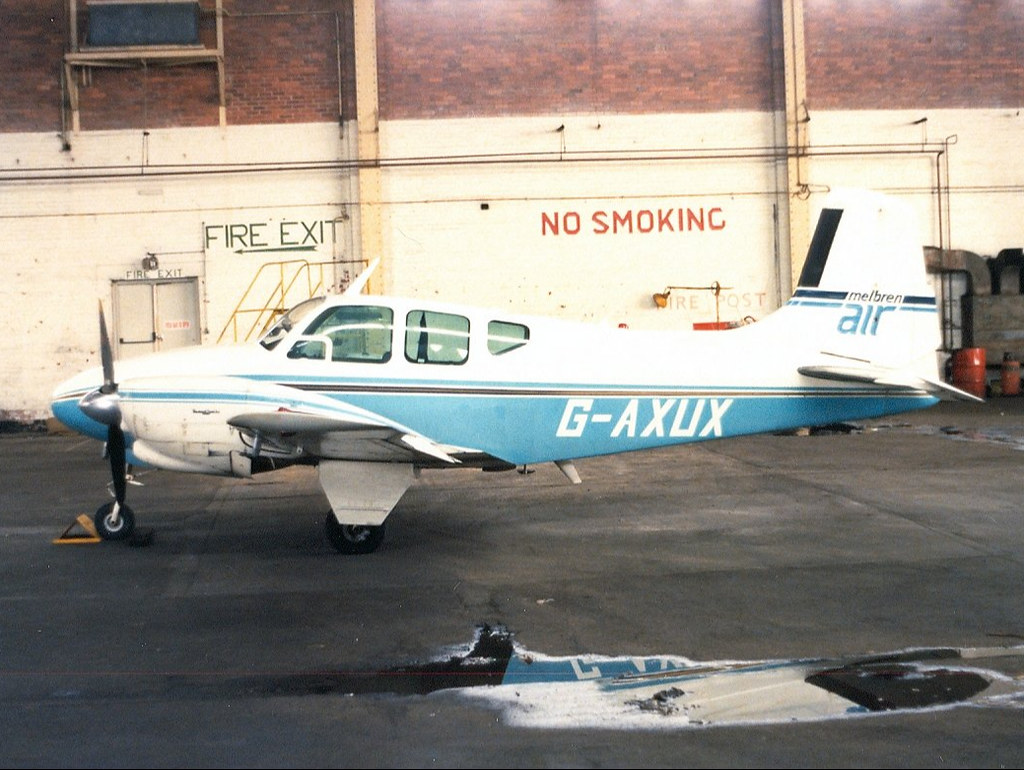Telair, Aviation West, Melbrenair & Walker
Jun 21, 2010 23:13:03 GMT 1
dovermire and argosy02 like this
Post by viscount on Jun 21, 2010 23:13:03 GMT 1
Telair 1981 - 1986
A Liverpool based Airline
This article researched and written by Brian Jones first saw the light of day in MAS 'EGGP' magazine, November 1986. Information on the early years was provided in a letter from Bob Greenough, their Deputy Operations Manager, dated 4/83.
A Liverpool based Airline
This article researched and written by Brian Jones first saw the light of day in MAS 'EGGP' magazine, November 1986. Information on the early years was provided in a letter from Bob Greenough, their Deputy Operations Manager, dated 4/83.
T E L A I R
THE BEGINNINGS
Telair was formed during 1979 as an aviation division of Telepoint Ltd of Manchester. At first no staff were directly employed, the main force behind the company being Mike Howells. After much dialogue with the C.A.A. Operations Inspector, their initial reservations over an operator with no staff were overcome, and after the required amendments were made, their Operations and Training Manuals were approved. Eventually the Operations Inspector wanted to take a flight as a fictitious passenger. After this, he was obviously happy with the operation as he granted the necessary Air Operators Certificate (A.O.C.) in March 1981. At this time just one aircraft was owned, a four seat Cessna F172N, G-BHKG, which had been purchased from Westair of Blackpool and based at Barton.
The A.O.C. was 'blooded' Easter weekend 1981, when the first two fare-paying passengers were carried aloft for a 45 minute flight around Cheshire and South Lancashire. These were the only people who responded to advertisements in the Press - which cost more than four times the revenue of the fares charged! At this time there were still no full-time staff. In May 1981 Telair were granted the fixed wing pleasure flying contract at the Manchester Air Show held at Barton Aerodrome. Although this was worked for the cost of fuel only, the rest of the takings being contributed to Lancashire Aero CLub funds, it was a start as they then were able to negotiate the pleasure flying concession at Barton. This pitch was worked successfully from the Club car park between June and September 1981.
INITIAL EXPANSION
The next step was expansion, to build on the experience gained. In order to move into the air charter, freight and air-taxi work a twin was necessary. In late 1981 a suitable aircraft was located at Blackpool in the form of Beech Travel Air G-AXUX. In January 1982 events moved on apace. Office accommodation was acquired in Manchester International Airport and they took on their first paid employees - a Chief Pilot and an Operations Assistant. The Travel Air was delivered from Blackpool on 19th January, the company being registered as 'Telair Manchester Limited'.
It quickly became evident that the Travel Air was too small for many potential charterers, so in March 1982 a Britten Norman Islander was purchased from Westward Airways in Cornwall. The fact that it was a nine passenger seat aircraft fitted in well with plans to increase the pleasure flying side of the business. The aircraft was delivered and came on-line in April 1982 in time for the Barton Air Show, where it proved to be an ideal aircraft for the pleasure flying trade. Eventually concessions for nine major civil and military air displays were won during 1982, using a combination of the Islander and Cessna 172 aircraft.
During 1982 the charter side of the business was steady with freight and passenger loads, plus a number of charters for aerial photography work. The islander in addition to charter and pleasure flying work, was kept busy with parachute drops for groups such as the 'Red Devils' and several parachute clubs.
MOVE INTO SCHEDULED SERVICES
With Air Charter and pleasure flying established, what would be the next step forward? Moving into scheduled services seemed a logical move, and after much deliberation, searching and discussion, an application for a licence to operate on a route Chester and/or Liverpool to Cardiff and/or Swansea was lodged with the C.A.A., and published in September 1982. The fares requested were Liverpool - Cardiff £47.50 single and Chester - Cardiff £37.50 single, with Islander and Travel Air equipment named on the application as the likely types. The licence would run for a period of 10 years from 1.1.83, if granted.
The Chester - Cardiff leg has been worked by three previous companies: Celtic, Euroair and Kraken. None had extended the route into Liverpool, which seemed to offer greater potential. The previous company to operate Liverpool - Cardiff had been Cambrian with Viscounts, being axed when they were absorbed into B.E.A. in the late 'Sixties.
While the C.A.A. were deliberating on the licence application a great deal had to be organised and made ready. In late 1982 a second Islander, G-AXWH, was located and purchased from Bristows since a 100% back-up was required. A vast amount of insurance was arranged at the insistance of the C.A.A. and capital raised to satisfy the C.A.A. that debts could be covered should the company collapse. The Operations Office was moved to Liverpool, taking accommodation in the main terminal, and a full-time Operations Manager employed for the first time. Extra staff and pilots were also employed once C.A.A. approval was granted and the start date set as late February 1983.
The inaugural flight, using both Islanders was made on the morning of Monday February 28th for the benefit of dignitaries and the Press. The first fare paying passengers on the "Welsh Connection" being flown, appropriately enough, on St. David's Day March 1st. The timetable called for a morning and evening return rotation.
TLR601 Liverpool (dep 0815) - Hawarden - Cardiff
TLR602 Cardiff - Hawarden - Liverpool (arr 1120)
TLR603 Liverpool (dep 1630) - Hawarden - Cardiff
TLR604 Cardiff - Liverpool ( arr 1930) (Chester being closed after 1800)
Being a small operator, Telair could be flexible, depending on bookings, stops could be omitted if not required. While the Islanders were the main aircraft employed on the service, during the first two months of operation the Travel Air G-AXUX and Kraken's Aztec G-BBYK (which had the advantage of being Cardiff based) were used on a number of days. Loads carried during the first month were not so high as anticipated, however improved after the C.A.A. approved (with effect from 19th April) new fares of Liverpool - Cardiff £37.50 single and a weekend return of £55.00.
During March a further route application was lodged with the C.A.A., this for Liverpool and/or Manchester to Southampton. Requested fare £53.00 single. It was hoped that approval would be given to allow a start on 1st June. C.A.A. approval was slow, and in July to speed progress Manchester was dropped from the application.
Loads on the "Welsh Connection" flights improved during May, with only the Islanders being used through until late September. An unusual class of passenger during the summer were prisoners and their escort - it being cheaper to fly them for trial in Cardiff day-return than it would have been to drive them and accommodate them and their guards overnight before and after the trial!
Throughout the summer thought was given to possible demand for new routes and considering the best timings. As a result of these deliberations, new schedules were introduced from September 5th. Swansea was now also to be served, with a circular route being proposed. The aircraft would now stop at Swansea overnight, thus the early morning flight would now be north-bound, rather than south-bound as previously. The schedule, from September 5th was timetabled as:
TLR601 Swansea (dep 0715) - Cardiff - Hawarden - Liverpool (arr 0920)
TLR602 Liverpool (dep 0935) - Hawarden - Cardiff - Swansea (arr 1150)
TLR603 Swansea (dep 1430) - Cardiff - Hawarden - Liverpool (arr 1635)
TLR604 Liverpool (dep 1645) - Hawarden - Cardiff - Swansea (arr 1850)
THINKING AHEAD
Also in September, the application for routes with the C.A.A. were amended. In addition to Liverpool to Southampton, they also requested services between Glasgow and/or Liverpool and/or Bristol and/or Cardiff. Fares requested being Liverpool - Bristol £37.50 single, Liverpool to Southampton £53 single and Liverpool - Glasgow £49 single. It was hoped to be able to commence services on January 6th, 1984. A 'hub and spoke' route network looked likely.
Much thought was made as to possible future equipment, as the Islander was clearly unsuitable for longer flights. The Bandeirane and Do.228 provided greater capacity and turbo-prop power, but presented a great step up in terms of cost, both purchase and operating. Cheaper alternative, particularly the smaller Navajo seemed a more likely path to take, at least initially.
Throughout the summer, particularly at weekends, other work was found for the aircraft. Parachute teams were carried aloft for drops over local shows, for example on April 9th over Aintree when the 'Red Devils' team dropped in on the Grand National meeting, on 19th June, and over New Brighton on 7th August. Pleasure flying contracts included Barton on 15th May and Swinderby on 4th June. Both Islander aircraft were used to transport an 18-strong party of M.A.S. members to the RAF Valley 'At Home' air display on 13th August. Short local pleasure flights were advertised in the Liverpool Press and a number flown throughout the summer period, including July 3rd on the 50th Anniversary of the Airport. In October they were extended upto Blackpool to view the illuminations from the air. Also on behalf of Strata Aviation, 'Flying Classroom' flights were flown in May. Using an Islander on April 29th a return flight to the Isle of Man was operated - this being a rare charter, as it did not interfere with having the aircraft fully available for the scheduled services every weekday.
MAIL CONTRACT GAINED, SCHEDULED PASSENGERS WOUND DOWN
In August a change in direction occurred. On August 12th, Biggin Hill based operator, Centreline went into receivership and terminated their contract with the Isle of Man Postal Board to fly mail between Ronaldsway and Liverpool. From Monday 22nd August, Telair operated most of the evening flights, with Manx Airlines flying the morning rotation mail on their scheduled flights. This regular traffic looked to be a much more certain money maker than flying passengers, so Telair submitted tenders for the whole IoM mail operation. They were successful and from October 3rd were awarded the full-time contract. This used both Islanders, six days per week.
As a result of both Islanders being tied-up on mail contract flights, coupled with a fall in demand on the Swansea/Cardiff to Chester/Liverpool flights, Aztec aircraft were leased in, being used from October 3rd. Two aircraft were used, G-BAVZ of Merseyside Air Charter and G-AYZC of North West Aero Services. This arrangement continued for two months, however demand in winter continued to fall short of expectations, and the scheduled service terminated on 28th November 1983. The actual last flight being the evening rotation TLR603/604 flown by Aztec G-BAVZ on Friday 25th November. Telair's excursion into scheduled services lasting 9 months. It was intended that the Southampton and Glasgow services would still be started in early in 1984. These route licences were actually never awarded by the C.A.A., the application eventually being suspended, along with that for the "Welsh Connection" on 23rd May 1984. With the failure of Telair to make the route pay, and with the failure of the Welsh Office to come up with any actual financial support to back up their promises, no other operator wanted to take-on providing this internal air route.
The mail contract called for two aircraft outbound to IoM around 0730 and two inbound from IoM around 2000 Monday to Friday and a morning return on Saturdays . Clearly using two aircraft with two crews was not the most economic way of operating the contract. Early evidence of the search for a suitable single aircraft came on October 28th with the arrival from Exeter of DH.114 Heron G-AXFH. After inspection the aircraft was found to be in poor condition, and after several false starts (which confirmed Telair's impression) eventually returned to Exeter. Trislanders too were investigated, however in January 1984 Aztec G-AYWG arrived and was immediately put into use on the IoM mail flights to cover during periods of Islander maintenance.
DIVERSIFICATION
In late October 1983 Telair had taken the lease on half of Hangar 5 (formerly NCP under cover car parking). Hangar 5 was behind Number 1, facing the rear side of No.3 Vernair hangar. After repair work to the doors, portacabins were installed as office accommodation and for spares holding. Aircraft could be hangared overnight, now that winter was approaching, and maintenance work performed between flights. To keep engineering staff occupied between work on company aircraft, overhaul of light aircraft could be accepted. In April 1984 an unairworthy Cherokee 140 was acquired from the receiver of Manchester School of Flying, this being brought back to full airworthy condition during 'slack' periods - a process that took over a year and half.
In March 1984 both Islanders were advertised for sale in 'Flight International'. G-AXXH suffered a slight apron accident on 26th March and the opportunity was taken to strip the aircraft down to bare metal (see photos in next post). It was sold and departed to Leeds in mid May in a yellow protective primer coat for Northair to prepare for dellivery to the Sudan. Its place being taken in the Telair fleet being taken by Navajo G-BEYY which arrived in late May 1984 in an attractive sand colour scheme. The IoM mail no being usually flown by Islander G-AXWH and Navajo G-BEYY, with the Aztec being used for occasional charter work and as a subsistitute aircraft if required. This pattern continued through the Autumn and into the Winter 84/85. Supplementary aircraft were leased in, if required, on a daily basis. Commonest of these during 1984 were Travel Air G-AXUX (now with Melbren Air) and Aztecs G-BAVZ (of Merseyside Air Charter), G-BBTL AND G-BFWE (both of Air Navigation of Blackpool).
The Islander was designed to be an adaptable aircraft, Telair proved this as other work undertaen by G-AXWH during Summer '84 involved Air Ambulance work between the IoM and Merseyside Hospitals; para-dropping eg June 6th & July 7th; 'Flying Classroom' flights for Strata Aviation eg May 11th & 15th; pleasure flights eg May 6th & 13th, August 4th (over the "Tall Ships" race), August 18th & 19th at the Liverpool Air Show and over 10 flights up over the Blackpool Illuminations during September and October (the cost being £15 per person).
Telair's G-AXXH even appeared on a postage stamp issued 27.4.84 by the Isle of Man. The 31p value showing the Islander over Ronaldsway on a mail flight. This emphasises the importance of the mail link with the mainland for the Island community, and Telair's part in flying the mail.
FURTHER CHANGES IN COMPANY POLICY
Telair's owner, Mike Howells, early in 1985 concluded a deal with Avon Air Services (trading as Aviation West) to bring Trislander aircraft to Liverpool to operate the IoM mail contract. Telair's own aircraft last operated on the mail 22nd March 1985, after one and a half years on the contract. The Navajo G-BEYY departed immediately for new owners, while Islander G-AXWH was hangared for two months before departure in May. The Aztec G-AYWG, which had been repainted August 1984 to match the Navajo, also departed for a new owner, leaving for Jersey in April.
Telair were not now without an aircraft, as during May a Twin Comanche, G-AYFT was acquired for charter work. Soon after, Cherokees G-BASI and G-BIYX together with a SV-4C Stampe, G-BXNW were acquired. These were mostly flown out of Barton, coming to Liverpool for maintenance work. The Cherokees being leased out to Barton and Blackpool based Flying Clubs for much of the time.
The Telair maintenance hangar at Liverpool was rarely empty, with an increasing number of privately owned and club aircraft calling for attention during Summer and Autumn '85, mostly Cessnas and Cherokees, but also Chipmunk, Aircoupe, AA-5 and Trislanders were dealt with. This business though, was not sufficient to keep up the rent on the hangar and engineer's salaries. So on Thursday 2nd January 1986, the portacabins and spares holdings were moved to Barton. On January 4th, both the Twin Comanche G-AYFT and Cherokee G-AVWD (on its first flight for years) flew off to Barton. Thus ended a near 3-year association with Liverpool Airport during which time it tried both scheduled passenger and contract mail operations in addition to general charter. The company continued to trade from Barton for a while before slipping into obscurity.
TELAIR - FLEET 1981-1986
Regn. Type Arrived, departed, notes
G-AVWD Cherokee 140 Del to LPL mid 4.84 by road, dismantled. Reflew and dep to Barton 4.1.86
G-AXUX Travel Air B95 Del to MAN 19.1.82. Sold to Melbrenair & dep 7.1.83
G-AXWH BN-2A Islander Del to MAN 18.11.82. Sold & dep to Ipswich 30.5.85
G-AXXH BN-2A Islander Del to MAN 6.82. Sold & dep to Leeds 19.5.84
G-AYFT Twin Comanche 160 Arr LPL 27.5.85. Dep for Barton 4.1.86
G-AYWG Aztec 250 Del MAN-LPL 16.1.84. Sold & dep to Jersey 6.4.85
G-BASI Cherokee 140 Acquired 3.85, operated at Barton or Blackpool
G-BEYY Navajo 310 Del MAN-LPL 29.5.84. Sold & dep to Stansted 22.3.85
G-BHKG Cessna F172N Acquired early '81. Sold and became VP-FBH 12.82
G-BIYX Cherokee 140 Acquired spring '85, operated at Barton or Blackpool
G-BXNW SV-4C Stampe Acquired summer '85, at LPL 7.85, but kept at Barton
All Telair Ltd aircraft were registered to Telepoint Ltd.
del = delivery, dep = departure, MAN = Manchester, LPL=Liverpool.



